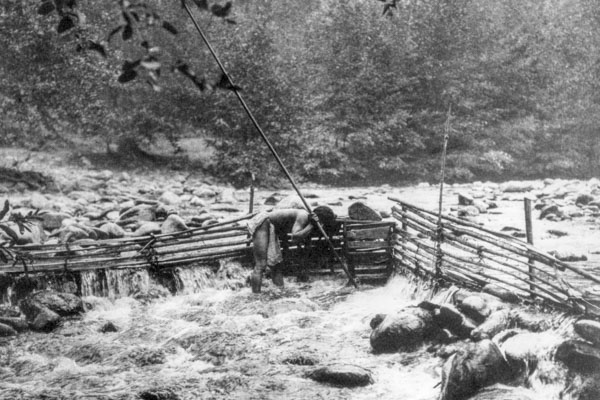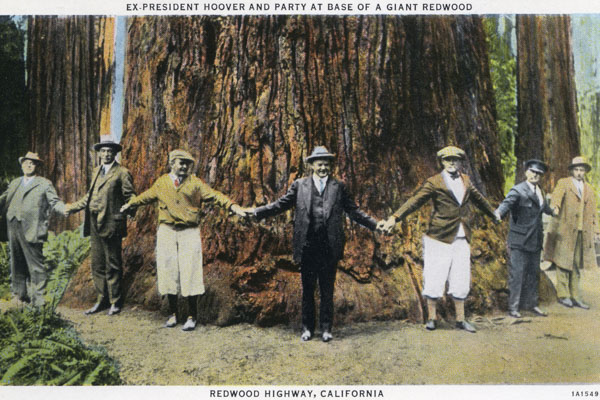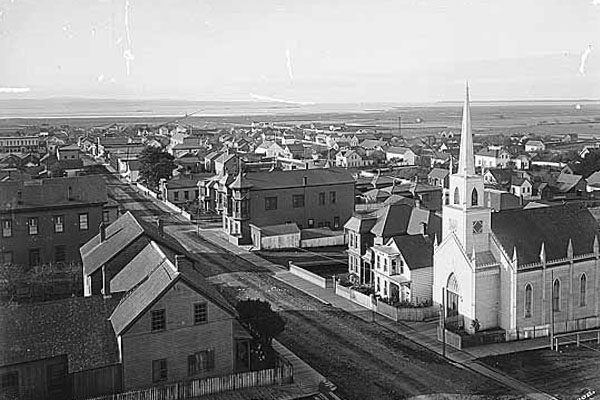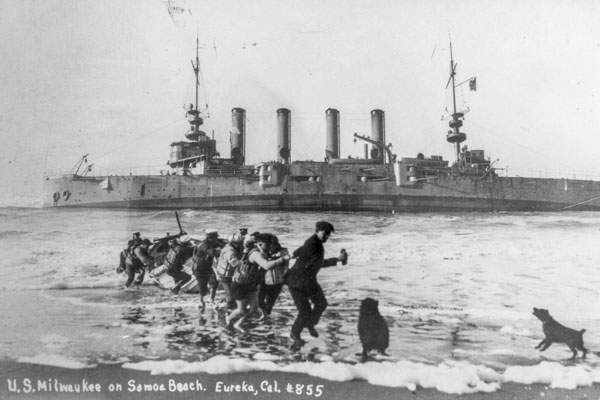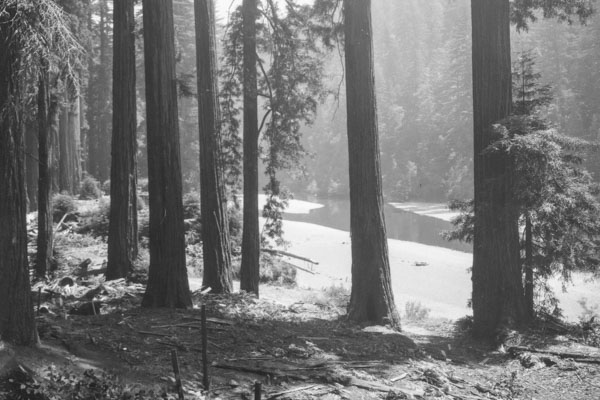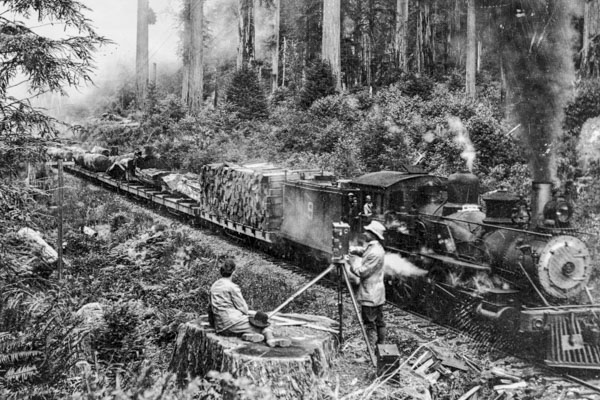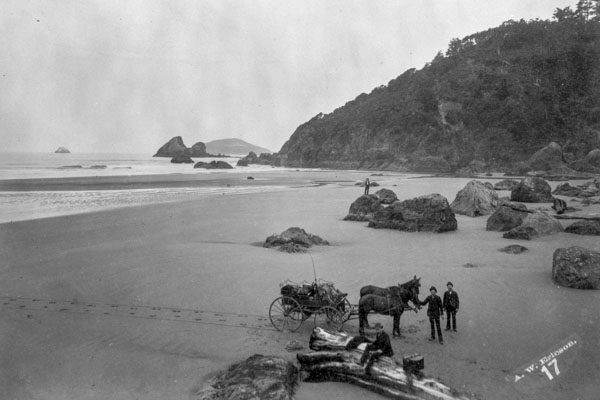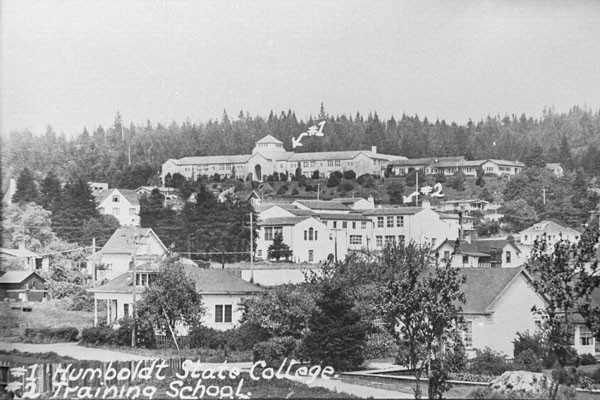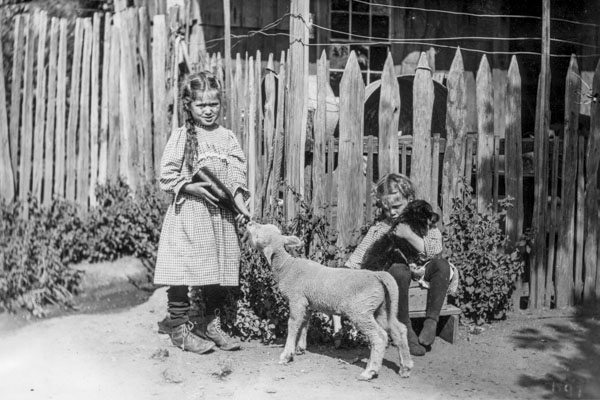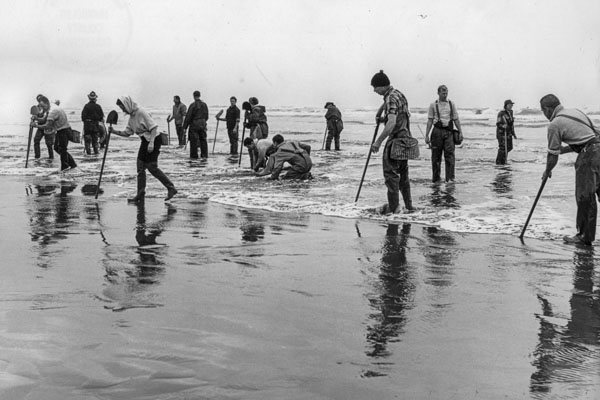You are here
Report on research trip to the Beinecke Rare Book and Manuscript Library
Report on research trip to the Beinecke Rare Book and Manuscript Library
Edie Butler
May 24-28, 2010, and April 2012
This trip was facilitated through the generous support of a travel grant from the Tracy Fund at the Humboldt Area Foundation.
Goals for research trip to the Peter E. Palmquist Collection at Yale University’s Beinecke Rare Book and Manuscript Library:
- Learn what metadata could be added to our records by reviewing the same images in the PP/B and noting the metadata available.
- Learn how the two collections do and do not relate to each other and to what degree there is overlap between the two collections. While I was at the Beinecke this goal was expanded to include identifying groups of photographs that would fill in gaps in photograph collections in Humboldt County repositories.
At the Beinecke I surveyed dozens of boxes of photographs that are still arranged just as Peter had them at his Arcata home. This was an advantage for me since I was familiar with them in that arrangement. Though I worked quickly I was able to review only about half of the Northwest California material.
PP refers to Peter Palmquist
PP/B refers to the Palmquist Collection at the Beinecke,
PP/HSU refers to the Palmquist Collection at Cal Poly Humboldt
The Relationship Between The Two Palmquist Collections
I wanted to see if there was information connected to individual images that was above and beyond what we had at for each image at HSU. For the portion of collection that I had with me there (about 1500 images that PP had filed by photographer) I did find about 10 instances where there was information that was in addition to what we already had. I had expected to find more. In the interests of time I paid close attention only to those that were not studio portraits.
Many images in PP/B have a small white sticker on verso with a handwritten number. That number nearly always corresponds to the number that is noted as the pp000 number in the “notes” field in the HSU Palmquist database, but some of the mismatches are due to PP having more than one numbering sequence. This makes it possible (for many images) to link a database record to an image in PP/B. I think PP used these small stickers for the images he obtained early in his collecting period and the practice probably tapered off as he began filing images by photographer, when known.
Many images in PP/ HSU are not in PP/B. These seem to be ones that he attributed to a source/collection indicating that he probably borrowed them and then returned the originals to the owner.
It appears that PP made copy negatives and prints for most of the images that were not studio portraits with notable exceptions listed below.
The two collections, the Humboldt County portion (including the women photographers images located in another part of the collection) at the Beinecke Library and the NW California portion at HSU Library, are related and have a great number of images in common. The database that we have developed at HSU can be immediately useful to researchers using the collection at the Beinecke especially for items that have a numbered sticker on the verso.
For those using the collection at the Beinecke the usefulness of the HSU database would be even greater if images were scanned and online so that more certain comparisons could be made. (In this instance and in all other mentions of scanning I am not referring to studio portraits, but to all other images.)
Peter did note considerable information on the negative envelopes and that combined with the knowledge that I and a small handful of other historians and heritage professionals possess adds significant information value to our database.
Clusters Of Images That Add To The Historical Record
I was particularly pleased, but not surprised, to find clusters of images at the Beinecke that do add substantially to the pictorial record of NW California history. I identified about 470 images that I am hopeful can be scanned and made available online. Some have extensive captions on verso so possibly versos would need to be scanned for about 100 of them. I did not focus on one or two photos here or there but rather on groups of photos. Anticipating that there would be requests for useful copies of them I think having a 400 DPI TIFF file would be most desirable. Perhaps, through a HSU-Beinecke collaboration, these images could be available to researchers. The expenses of scanning are considerable, just as are the expenses of cataloging and data entry.
I did not have time to finish reviewing the boxes of Humboldt County photographers (males A-Z, nor most of the women) and I did not review the Humboldt County images by unknown photographers at all. In addition to these unfinished categories I would want to view the Siskiyou photographers (likely they are included with the California men) and the Arcata Union photographs if I am ever able to travel to the Beinecke again. I suspect that with a more thorough review of the collection there would be more clusters of images that would fall into this category.
I have considered the various ways that access through each library’s website might bring these images to the public. My primary goal would be to have these images available to Humboldt region bound researchers since they do add to what we already have among the various repositories. I don’t think it matters too much whose website hosts them so long as there are cross links to the other’s website. I do think that it would be useful to have them item level cataloged so that they could be accessed similarly to our other photo collections but it might be acceptable to many researchers to have them online as a “slide show” broken into segments. Usually these were from the middle decades of the 20th C and are outside the period that PP focused on most heavily; ie: the pre WW I era.; I recommend that copies of the following be sought.
Before listing a sampling of these clusters I want to mention another fortunate discovery. Libby Palmquist accompanied me on this visit to view the photos that PP himself took in Humboldt County (MSS 509) for images of her family and I discovered that there are a significant number that add to the region’s historical record. There are envelopes that contain many contact prints and many negatives labeled with topic or project names. Selections of 5-10 could be made from each of them.
Box 72: Fire in Twin Parks area, May 1965, “Eye Sores”1966, logging
Box 91: Boat Basin August 1961, log pond at an Arcata mill May 1961, lumber mills February 1961
Box 96: Eureka billboards and business signs 1967
There are likely more, these are just the ones that I saw. My guess is that about 75-100 of these would be great additions to the historical record available to researchers in NW California.
CLUSTERS
In Beinecke MSS 128:
Art-Ray PP/B box 13? (Same as PP box 1); PP box 4; PP/B box 70
NW California towns and mills, especially the oversize postcards
Approx 60
Cherry PP/B box 18
Some Hoopa Valley, some towns; all non- redwoods and mills images should be scanned
Approx 12
Flaglor PP/B box 24
Fort Gaston
Approx 10
Freeman Art Co. PP/B box 25
Nearly half the box- Save the Redwoods League women, Fields Landing Whale Station, Hammond Lumber Co. , shops and markets both interior and exterior, women quilting
Approx 40
Kilburn PP/B box 30
Woolen mill and interior shot of woman working; Chamber of Commerce with information on verso
Approx 15
Seely PP/B boxes 82 and 83 PP Box 1
Many from 1950s; store displays, street scenes, Rotary Club, businesses, Logging (Korbel area) with information on verso, Hoopa church
Approx 25
Strong, N. B. PP/B box 39
Hoopa – buildings (including hotel, hospital), views, river
Approx 14
Swanlund Brothers PP/B box 84
Chamber of Commerce – road intersections (identified)
Approx 10
Swanlund, Dave PP/B box 85
Logging, mills, roads, road intersections, aerial, more Chamber of Commerce
Approx 30
Images attributed to women photographers are part of the Women in Photography International Archive
WA MSS S-2600
Bowman
NWP’s first run and celebration, Weymouths, Dyerville and surrounding area
Approx 20
From the boxes with multiple male photographers per box: A-Z:
Eureka Newspapers, Inc
Chamber of Commerce: Ruth Dam; Humboldt Bay shipping, jetties, dredging; Kinetic Race sculptures, crowds; 1964 flood especially because of the explanations on the verso (approx 16)
Approx 36
Johnson, Craig
1970s-1980s: rodeo, parades, sports, teacher/classroom, fire, picnic/Camp Bauer, plywood mill, crab picking and processing, dance class, King Salmon PG and E plant
Approx 150
KIEM –TV
1960s: public figures – identified
Approx 20
Menefee, Dr. Peter M.
Approx 8
Phillips, Denver (owned Phillips Camera Shop)
Plaza – parade and Marching Lumberjacks
Approx 3
Redwood Empire Assn.
Road intersections, forest products in transport
Approx 8
Redwood Empire Photographic Service
Arcata, moving press at Arcata Union, huge gathering on the Plaza
Approx 6
I ran out of time before I was able to finish the rest of the alphabet or review most of the women photographers. Other areas that I did not review are: A. W. Ericson photographs, Humboldt County images not filed by photographer’s name, photographers from surrounding counties, especially Siskiyou County, and Arcata Union newspaper photographs.
Research trip in April 2012
During a 2010 visit to the Peter E Palmquist Collection at the Beinecke I observed that there was significant overlap between the Peter E. Palmquist Working Photograph Collection at Cal Poly Humboldt and the Humboldt County Photographers portion of the collection at the Beinecke, and further noted that the database records created for the collection have more complete information for many of the images. During that visit I started a list of photographers for whom the HSU collections had fewer images. Quickly it became apparent that any new effort in the Palmquist Collection at the Beinecke should focus on images from the mid 20th Century, including images taken by Palmquist himself. Discussions for a return trip started shortly after the 2010 trip.
During the April 2012 visit to the Beinecke to select the images I reviewed images by photographers known to be active during the mid 20th Century. While reviewing box after box of images noting the ones that would fit the criteria of mid 20th Century I also selected some that would nicely supplement existing collections of earlier decades. Beinecke Library personnel digitized the images and Edie Butler cataloged them at HSU. The HSU database records have been made available to the Beinecke Library. This cooperative arrangement between two repositories makes these 740 images more widely available to all researchers.
The sheer size of the Peter E. Palmquist Collection coupled with the fact that Humboldt County male photographers, Humboldt County female photographers, photographers from surrounding counties, and Peter Palmquist's own photographs are each held in distinct parts of the overall collection made budgeting time over the two work weeks challenging. The goal was to select "about 700" images. I requested boxes containing images by male photographers I knew to be mid-20th Century and then reviewed the other contents of the box. This allowed for serendipitous finds, such as the Hoopa images by Edgar Cherry. At a certain point I had to stop looking at Humboldt County male photographer boxes because I needed to review images by Palmquist himself.
In the boxes of images taken by Palmquist I was confronted with envelopes of dozens, sometimes hundreds, of negatives so it became difficult to select the best examples. Communicating, using the forms and process at the Beinecke, exactly which few were to be digitized would have no doubt created many moments of confusion and frustration for all parties. Therefore, sometimes the best solution was to select an entire batch. Peter was a professional photographer; his artistic and technical abilities are evident in his images. Until now Palmquist's own images have not been widely available in his home region. Nevertheless, the batches selected for this collection represent a small percentage of Palmquist's work.
Next I reviewed boxes holding Humboldt County women photographer images. I never did review boxes holding photographs from the counties surrounding Humboldt. Time was running short and I was already at the agreed upon tally number; actually I was over that number somewhat.
